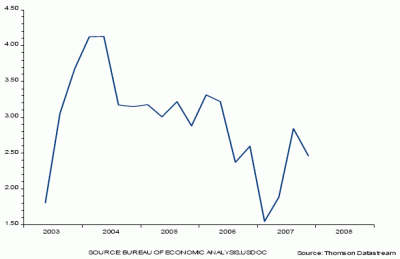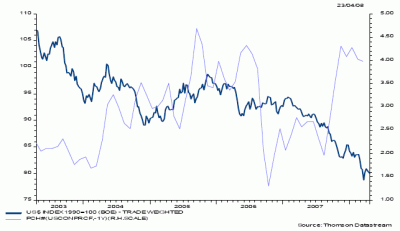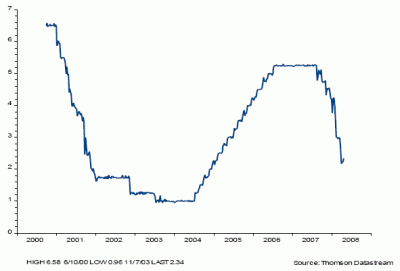Last week we concentrated on the outlook for domestic UK economic activity ahead of the release of the first stab at UK real gross domestic product (GDP).
This week the markets face an even sterner test with the release of a swathe of important first line economic data in the United States including the all important first estimate of that country's real GDP, coupled with base rate decisions from the Federal Reserve and the Bank of Japan.
Ahead of what could prove a momentous week we think it pretty safe to say that, when the dust has settled, it won't be the Bank of Japan that everybody's talking about!
MoneyWeek
Subscribe to MoneyWeek today and get your first six magazine issues absolutely FREE

Sign up to Money Morning
Don't miss the latest investment and personal finances news, market analysis, plus money-saving tips with our free twice-daily newsletter
Don't miss the latest investment and personal finances news, market analysis, plus money-saving tips with our free twice-daily newsletter
We have, for some time, argued that the US economy is already in recession and that it probably entered recession in December of last year. We will know whether we're right or not on Wednesday at 13.30pm BST!
Crunch time for US real gross domestic product has arrived

In a moment of heroic (and possibly mis-placed) optimism we forecast that US GDP will increase by 1.2% over 2008, having grown by 2.2% in 2007 and 3.3% in 2006. If the US economy is to get anywhere near our number a huge weight of expectation must be placed on the country's export sector. Certainly there are some grounds for guarded optimism. Net external demand is indeed likely to be the major driver of activity over the year and Q1 2008 has already been characterised by a marked improvement in the country's underlying trade deficit. That said, we accept that this improvement has been offset in part by the higher price of imported oil.
Elsewhere, the fall-out from the credit crunch continues, a litany of downbeat economic data weighing on consumer confidence and expenditure. In its recent assessment the International Monetary Fund broke free from its guarded reputation to indicate that, in its view, the potential losses emanating from the sub-prime crisis and ensuing near-collapse in the US financial system could cost nearly $1,000bn.
Although a number of this magnitude looks big it is, in fact, quite small in relation to its share of GDP, particularly in the context of earlier financial crises and the fact that the pain is being shared between the US and Europe.
The real problem is that it is likely to take months and possibly, if the pessimists are right, years to unwind the mess created as a result of the build-up of speculative excesses over the past five years. As the highly regarded economist Mr Roger Bootle has observed "the umpteen billions of dollars which have been magicked out of nowhere must return from whence they came". In a week in which the Bank of England followed the Federal reserve's suit and announced its unprecedented "special liquidity scheme" and the Royal Bank of Scotland unveiled a £12bn rights issue, the largest ever by some margin, it is entirely obvious that the financial sector is struggling to squeeze the genii back into the jar and that in so doing there will be pain for everybody.
Although the Federal Reserve is now entirely focused on avoiding a prolonged recession in the United States, activating measures enacted at the time of the Great Depression in the 1930's and cutting base rates aggressively, to just 2.25% from a peak of 5.25% as recently as last autumn, there comes a point at which monetary policy makers have to step back and see what the impact of their actions is.
Admittedly, we are pretty convinced that the Fed doesn't think that it can afford that luxury just yet. On the same day that observers get to see the first estimate of US economic output growth, the Fed's Open Markets Committee pronounces on base rates at the end of its two-day meeting. According to consensus estimates the financial markets think that sufficient scope exists from the data released so far for a further 0.25% point reduction in the Funds rate, to just 2.0%!
On the basis that it can take between six and twelve months for a base rate reduction to feed its way into the real economy we might expect the first positive manifestations of last September's initial cut to at least provide partial support in tandem with a swathe of tax rebates to be issued over the coming few weeks.
That base rate reductions are not having the desired effect already is in large part down to the freezing up in the inter-bank market and continued high inter-bank rates. That these rates have barely moved, despite aggressive action on the part of the authorities goes a long way towards illustrating how grave the prevailing situation is and how, if conditions don't start to improve soon, even more aggressive action might be required.
Given that Dr Bernanke has spent a life time studying how to avoid an all-out deflationary spiral, that he has written on the subject and spoken formally on the subject and is now in a position to actually do something about it, how far can we be from letting the printing presses roll?
Trade weighted dollar falls as US headline inflation spikes

This might seem an unusual position to hold with inflationary indicators flashing red and the dollar in virtual free-fall against almost every major currency except sterling, however, we continue to argue that inflation is a lagging indicator and that recession, coupled with the rise in unproductive spare capacity that it will inevitably bring, should act as a powerful disinflationary force as the year progresses.
Again, far from bravely, we forecast headline US consumer price inflation of 3.3% over 2008 (against 2.9% in 2007), however, the impact of the above, coupled with plunging private sector payrolls (non-farm payrolls have never fallen by a monthly average of c100,000, as they did over Q1 2008 in any period other than recession), the continued slow motion train wreck in the residential property market (residential investment is currently falling at an annualised 25% rate, taking more than 1% point off overall GDP) and a sharp rise in petrol prices at the pumps are all serving to bear down on
consumer demand. For these reasons we expect to see US headline inflation fall back to c1.6% in 2009.
At this point it might be worth speculating what might happen if we were wrong and inflation did rise sharply, possibly in response to drastic action on the part of the Fed to head off a debt-deflationary spiral. Critically, Dr Bernanke and his coterie at the Federal Reserve squat toad-like on control of the supply of dollar bills. He has consistently maintained that he would do whatever it takes to maintain and preserve the US financial system. He will have seen warning lights flashing across the system ahead of the tumultuous decision to allow Bear Sterns to fall into the arms of JP
Morgan and the concurrent decision to extend the Fed's facilities beyond the traditional banks. He will know that when crises occur the action required to head them off must be immediate and the amounts involved substantial.
A massive amount of paper would be required to reflate the US economy and in so doing the dollar would be compromised. Despite the US administration's attempted assertions to the contrary (inevitable in an election year) we suspect that dollar weakness is absolutely part of Dr Bernanke's agenda. Not a precipitous collapse in the currency but a gradual and steady reduction in value, manifest in both the exchange rate and the inflation rate.
With enough leverage around to sink a battleship it does make practical sense to carry out part of the deleveraging process through
the currency. The most important point is that all this will only help highly indebted households as long as interest rates stay below the rate of inflation (as Britain discovered in the 1970's).
The bottom line is, therefore, that we expect US authorities to oblige and base rates to continue falling, possibly back to as low as 1% point, irrespective of the near-term cost in terms of inflation. In such circumstances investors are unlikely to want to hold cash, they are likely to want index-linked gilt edged and they may start adding risk to equity portfolios, with some trepidation, on the basis that radical action will, ultimately, pave the way to salvation.
Aggressive rate cuts from the Federal Reserve. How many left?

By Jeremy Batstone-Carr, Director of Private Client Research at Charles Stanley
Get the latest financial news, insights and expert analysis from our award-winning MoneyWeek team, to help you understand what really matters when it comes to your finances.
MoneyWeek is written by a team of experienced and award-winning journalists, plus expert columnists. As well as daily digital news and features, MoneyWeek also publishes a weekly magazine, covering investing and personal finance. From share tips, pensions, gold to practical investment tips - we provide a round-up to help you make money and keep it.
-
 Why pension transfers are so tricky
Why pension transfers are so trickyInvestors could lose out when they do a pension transfer, as the process is fraught with risk and requires advice, says David Prosser
-
 The political economy of Clarkson’s Farm
The political economy of Clarkson’s FarmOpinion Clarkson’s Farm is an amusing TV show that proves to be an insightful portrayal of political and economic life, says Stuart Watkins

